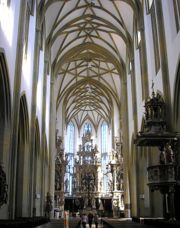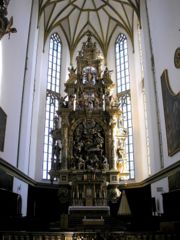
St. Ulrich's and St. Afra's Abbey, Augsburg
Encyclopedia


Ulrich of Augsburg
Saint Ulrich , sometimes spelled Uodalric or Odalrici, was Bishop of Augsburg and a leader of the Roman Catholic Church in Germany. He was the first saint to be canonized.-Family:...
and Saint Afra
Saint Afra
Saint Afra was a Christian martyr. Her actual existence is not mentioned until the 5th century martyrologies, giving her dubious historicity.-Biography:...
in the south of the old city in Augsburg
Augsburg
Augsburg is a city in the south-west of Bavaria, Germany. It is a university town and home of the Regierungsbezirk Schwaben and the Bezirk Schwaben. Augsburg is an urban district and home to the institutions of the Landkreis Augsburg. It is, as of 2008, the third-largest city in Bavaria with a...
, Bavaria
Bavaria
Bavaria, formally the Free State of Bavaria is a state of Germany, located in the southeast of Germany. With an area of , it is the largest state by area, forming almost 20% of the total land area of Germany...
.
History
The Benedictine monastery was preceded by an original foundation established at an uncertain date, but at least as early as the 10th century (and in its turn quite possibly a refoundation of a still earlier one from the 5th or 6th centuries), by the "Kollegiatstift St. Afra", a community of the priestsCanon (priest)
A canon is a priest or minister who is a member of certain bodies of the Christian clergy subject to an ecclesiastical rule ....
charged with the care of St Afra's Church (now the Basilica of Saints Ulrich and Afra), where the relic
Relic
In religion, a relic is a part of the body of a saint or a venerated person, or else another type of ancient religious object, carefully preserved for purposes of veneration or as a tangible memorial...
s of Saint Afra were venerated, and next door to which the community premises were built.
Between 1006 and 1012, Bruno, Bishop of Augsburg
Bruno of Augsburg
Bruno was the son of Henry II, Duke of Bavaria and Gisela of Burgundy. He was the brother of St. Henry II of Germany, the only Holy Roman Emperor to be made a saint. Bruno was Bishop of Augsburg from 1006 or 1007 until 1029.Bruno of Augsburg lived at a time when Christianity was still making...
, removed the canons to the cathedral chapter
Cathedral chapter
In accordance with canon law, a cathedral chapter is a college of clerics formed to advise a bishop and, in the case of a vacancy of the episcopal see in some countries, to govern the diocese in his stead. These councils are made up of canons and dignitaries; in the Roman Catholic church their...
and gave the premises to Benedictine monks whom he brought from Tegernsee Abbey
Tegernsee Abbey
Tegernsee Abbey or the Imperial Abbey of Tegernsee is a former Benedictine monastery in the town and district of Tegernsee in Bavaria. Both the abbey and the town that grew up around are named after the Tegernsee, the lake on the shores of which they are located...
, thus turning it into a Benedictine monastery. It was granted Imperial immediacy as an Imperial abbey in 1577, but this status was bitterly contested by the bishops of Augsburg
Prince-Bishopric of Augsburg
The Prince-Bishopric of Augsburg was one of the prince-bishoprics of the Holy Roman Empire, which belonged to the Swabian Circle.-Early period:...
, and the legal conflict was resolved in favour of the abbey only in 1643/44.
The abbey was dissolved in 1802 during the secularisation
German Mediatisation
The German Mediatisation was the series of mediatisations and secularisations that occurred in Germany between 1795 and 1814, during the latter part of the era of the French Revolution and then the Napoleonic Era....
of Bavaria
Bavaria
Bavaria, formally the Free State of Bavaria is a state of Germany, located in the southeast of Germany. With an area of , it is the largest state by area, forming almost 20% of the total land area of Germany...
. The city of Augsburg and the state of Bavaria divided its territory between them. The monks however were permitted to remain in the premises of the dissolved monstery. In 1805 a French
France
The French Republic , The French Republic , The French Republic , (commonly known as France , is a unitary semi-presidential republic in Western Europe with several overseas territories and islands located on other continents and in the Indian, Pacific, and Atlantic oceans. Metropolitan France...
military hospital was installed here; after six monks, including the abbot, had died of infectious diseases, the remainder moved into a private house. The hospital was replaced in 1807 by a Bavarian cavalry barracks, known as the "Ulrichskaserne".
The barracks remained here until World War II
World War II
World War II, or the Second World War , was a global conflict lasting from 1939 to 1945, involving most of the world's nations—including all of the great powers—eventually forming two opposing military alliances: the Allies and the Axis...
, when in 1944 the buildings were largely destroyed. The remains were not cleared until 1968–71. On the site the "Haus St. Ulrich" has stood since 1975, an academy and pastoral centre of the Diocese of Augsburg. The sarcophagus
Sarcophagus
A sarcophagus is a funeral receptacle for a corpse, most commonly carved or cut from stone. The word "sarcophagus" comes from the Greek σαρξ sarx meaning "flesh", and φαγειν phagein meaning "to eat", hence sarkophagus means "flesh-eating"; from the phrase lithos sarkophagos...
es of Saint Afra and Saint Ulrich are preserved in the crypt.
Abbots of St. Ulrich's and St. Afra's Abbey
- RegimbaldRegimbaldRegimbald was a Benedictine abbot of Lorsch Abbey, and bishop of Speyer, from 1032. He was previously at the abbey of Saints Ulrich and Afra and at Ebersberg Abbey.He is a Catholic and Orthodox saint, feast day October 13....
(c. 1012–15) - Dego (1015–18)
- Gotstegen (1018–20)
- Fridebold (1020–30)
- Heinrich I (1031–44)
- Tieto (1044–50)
- Adelhalm (1050–65)
- Diemar (1065–80)
- Sigehard (1080–ca 1094)
- Hartmann (1094–96)
- Berengar (1096–1107)
- Adalbero (1107–09)
- Gunther (–1109)
- EginoSaint EginoEgino was born in Augsburg, Bavaria, Germany, was Camaldolese abbot involved in the many disputes of his era. Egino was placed in the abbey of Sts. Ulric and Afra as a child. He became abbot of the abbey but was expelled when he supported Pope Callistus II against Emperor Henry V in a dispute....
(1109–20) - Wollemar (1122–26)
- Udalschalk (1127–51)
- Hezilo (1156–64)
- Ulrich I of Biberbach (1169–74)
- Heinrich II of Meysach (1177–79)
- Manegold (1182–84)
- Heinrich III (1187–90)
- Erchenbold (1193–1200)
- Ulrich II (–1204)
- Heinrich IV of Belsheim (1213–16)
- Dietho (1221–25)
- Luitfrid (1225–30)
- Hiltibrand of Thierheim (1234–41)
- Gebwin of Thierheim (1241–66)
- Dietrich of Rodt (1277–88)
- Sibotho Stolzkirch (1288–92)
- Heinrich V von Hagenau (1292–1315)
- Marquard von Hageln (1316–34)
- Konrad I Winkler (1334–55)
- Johannes I von Vischach (1355–66)
- Friedrich von Gummeringen (1368–79)
- Heinrich VI von Gabelbach (1382–96)
- Johannes II Lauginger (1396–1403)
- Johannes III Küssinger (1404–28)
- Heinrich VII Heutter (–1439)
- Johannes IV von HohensteinHohensteinHohenstein may refer to several different places in Germany, including* Hohenstein-Ernstthal, in Saxony* Sayn-Wittgenstein-Hohenstein, a county of the Holy Roman Empire , situated between Hesse-Darmstadt and Westphalia...
(1439–58) - Melchior von Stamheim (1458–74)
- Heinrich VIII Fryess (1474–82)
- Johannes V von Giltingen (1482–96)
- Konrad II Moerlin (1496–1510)
- Johannes VI Schrott (1510–27)
- Johannes VII Koenlin (1527–39)
- Heinrich von Foehr (1539–48)
- Jakob Koepplin (1548–1600)
- Johannes VIII Merk (1600–32)
- Bernhard Hertfelder (1632–64)
- Gregor I Jos (1664–74)
- Roman Daniel (1674–94)
- Willibald Popp (1694–1735)
- Coelestin Mayr (1735–53)
- Joseph Maria von Langenmantl (1753–90)
- Wikterp Grundner (1790–95)
- Gregor II Schäffler (1795–1802)

